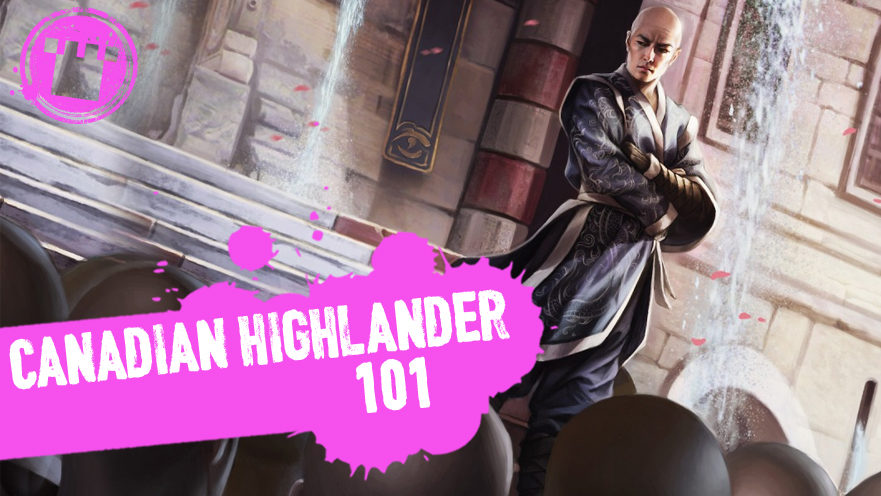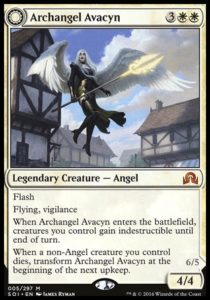Have you ever looked at your Magic: The Gathering collection and thought to yourself, “Gee, I only have one copy of each of these Legacy staples! I wish I had enough to build a full deck!”
Well, I have a solution for you! I want to take a moment to champion a Magic format that has quickly become my ideal way to play Constructed: Canadian Highlander. Canadian Highlander (or CanLander for short) was created more than fifteen years ago in the city of Victoria, British Columbia, as a creative outlet for Eternal format players, and it’s becoming increasingly popular south of the Canadian border.
What is Canadian Highlander?
Canadian Highlander is a singleton format where decks need to have a minimum of 100 cards, and battles take place 1 v 1. What does that mean? Your deck can have any number of cards in it, but you can only play one copy of each of those cards (excluding basic lands, of course…or Shadowborn Apostles, if you want to summon some demons).
This format may sound a lot like Commander to you, and frankly, that’s something we CanLander players hear from a lot of newcomers. But there are some key differences that set Canadian Highlander apart from its more well-known singleton cousin:
-
- You don’t play with a Commander; therefore, your deck has no color identity restrictions.
-
- Canadian Highlander games are 1 v 1. No multiplayer games here!
-
- You start the game with 20 life.
- Most importantly, Canadian Highlander uses the Vintage Ban List.
The very mention of Vintage makes some Magic players think nightmarish thoughts of Tinker into Blightsteel Colossus, but fear not: there’s one final caveat that significantly limits the power of Canadian Highlander decks without limiting the creative possibilities.
The Points List
It was very important to CanLander designers and players that the format adhere to the Vintage banned list. In order to balance the power and keep the format fresh, CanLander uses a points list, which assigns a numerical value (1-10) to the most high-impact legal cards. You’ll note that Canadian Highlander decks have a minimum of 100 cards, but no maximum. For every 100 cards in your deck, you are allotted ten points to spend. So while you can absolutely play that Black Lotus you have in your binder (doesn’t everyone?), you’ll find it uses up seven of your allotted ten points. The points list is updated relatively often, as new cards enter the format and existing cards’ values are adjusted.
If you’re looking for more information on Canadian Highlander, our good friends at LoadingReadyRun have recently launched a new podcast devoted to the format! In Episode 0, the hosts give a great breakdown of the format and why they enjoy it so much.
Canadian Highlander is the first Constructed format that felt like a good fit for me. Until I discovered this format, I was strictly a Limited player who would dabble in Constructed when I was given a deck to pilot. Now all I want to do is spread the word of the North and jam some games with everyone I can.
Sample Decks
Finally, let’s get to the part you came here for: the sweet deck techs! Leading it off is my personal deck, which I call Generic Esper Midrange, or G.E.M. for short. You can view my full list on TappedOut and purchase all the pieces from Card Kingdom.
The price of this deck may seem high, but the number is a bit deceptive. Since Canadian Highlander is not a tournament format, many players choose to outfit their decks with Collectors Edition versions of the priciest cards, which brings the cost of owning a deck down significantly. That gives players more room to be creative and build CanLander versions of their favorite Constructed or Limited decks; I built my deck after having a ton of success playing Esper Midrange in Modern Masters 2017 draft.
A few weekends ago, I got to experience the depth and breadth of the Canadian Highlander format at LoadingReadyRun’s Canadian Highlander meet-up at PAX West. My friend Ben and I finally got to throw down some games, and his fantastic Izzet Counter-Burn budget brew absolutely destroyed me. I quickly learned to fear Price of Progress and Dualcaster Mage, since my deck runs lots of non-basics.
Before we end this introduction to Canadian Highlander, I want to tell you about the most flavorful spell interaction I’ve seen in this delightful format. My good friend Robert was one of the people who pushed me to jump into the format, and I’ve spent a lot of time getting to know his Abzan Hate Bears deck. Robert was making a fairly safe attack into my board to keep up the pressure, but little did he know I had my good friend Archangel Avacyn in hand. I declared blockers and flashed in Avacyn, making my creatures indestructible and putting me in a good position to win the game the following turn. Then, Robert cast Anguished Unmaking (a recent addition to his deck) targeting Avacyn — a flavor win that almost made me concede on the spot. I love seeing the cool spell interactions that rarely come up in other Constructed formats.
If you’re looking for a new casual format to try, I urge you to consider brewing some Canadian Highlander decks with your friends. If you have any further questions or want to talk shop about your favorite CanLander deck lists, feel free to reach out to me on Twitter @RayEffKay.
Header image: “Monastery Mentor” by Magali Villeneuve


